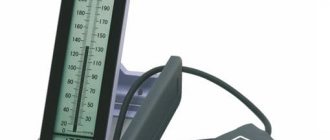Blood pressure is a kind of indicator. It shows the state of a person’s heart at the moment. It is not permissible to draw conclusions about health based only on the tonometer readings, but the readings of the device can give a signal if the heart begins to malfunction. And this means it’s time to contact a specialist. The device readings are encrypted into a special symbol system. Knowing what the numbers on a blood pressure monitor mean, you can prevent many serious conditions.
SYS and DIA numbers
Two numbers located one below the other indicate systolic and diastolic pressure. The first is measured during the ejection of blood or contraction of the heart muscle, and the second while it is relaxed. DIA (diastole) indicates the level of lower pressure, and SYS (systole) indicates the upper pressure.
Systole and diastole indicators on a tonometer
The normal rate is 135/85. Having seen such tonometer readings on the display, which mean the absence of hypertension and hypotension, you don’t have to worry about your health. For a more accurate result, it is better to take a measurement first on one hand and then on the other and calculate the arithmetic average of the two indicators.
Another significant factor is the difference between the upper and lower indicators. If the measurements show a difference much less or more than 50, then the user should report this fact to the attending physician.
A state of rest during diagnostics will help to avoid errors in the device readings. It is prohibited to speak or move until data appears on the device display.
What do the numbers on the tonometer mean?
The device for measuring pressure is called a tonometer. It comes in two types - mechanical and electronic. The latter, in turn, can be automatic or semi-automatic. The mechanical device uses the sound (auscultatory) method: air is pumped manually, and the pulse rate is listened to using a stethoscope. This method requires certain skills. The use of an electronic tonometer makes the measurement process very simple, which is why these devices are recommended by experts for use at home. In a semi-automatic device, air is pumped as in a mechanical tonometer, and in an automatic one - by software. In both devices, pressure readings are automatically displayed on the electronic display.
Modern tonometers show not only blood pressure, but also pulse, charge level...
Blood pressure is measured in millimeters of mercury and is designated by two numbers separated by a right slash: 120/80 mmHg. Art., where the first digit is the systolic indicator (sys), and the second is the diastolic indicator (dia). The third number on the tonometer shows the pulse rate. Pulse measurement allows you to find out about possible disorders in the cardiovascular system. In a healthy adult, the heart beats at a rate of 60-80 beats/min. The tonometer readings may be unreliable if the manipulation rules are not followed. Blood pressure should be measured in a quiet sitting position, the arm should be relaxed, and the cuff should not be lower than the level of the heart cell.
Heart rate
The third digit located on the device display is the pulse. This figure is located in the bottom row under the pressure indicators.
Heart rate indicator
It is not difficult to understand what this or that number located on various models of tonometers for measuring pressure means. Heart rate depends on the age and gender of a person; on average, this indicator varies from 60 to 90 beats in 60 seconds. A rarer pulse may indicate bradycardia, a more frequent pulse may indicate tachycardia.
Normal by age
The working blood pressure of an adult is considered to be between 110/70 and 130/80 mm. But with age, these numbers may change! This is not considered a sign of illness.
You can track changes in blood pressure as a person gets older in the table:
| Age | Men | Women |
| 20 years | 123/76 | 116/72 |
| Up to 30 years old | 126/79 | 120/75 |
| 30-40 years | 129/81 | 127/80 |
| 40-50 years | 135/83 | 137/84 |
| 50-60 years | 142/85 | 144/85 |
| Over 70 years old | 142/80 | 159/85 |
The lowest blood pressure is observed in children! As a person grows older, it increases and reaches its maximum levels in old age. Hormonal surges that occur during adolescence in adolescents, as well as pregnancy in women, can increase or decrease it.
The norm of pressure depends on the individual characteristics of the body of individual people.
High blood pressure, which can be called pathology, is considered to be 135/85 mm and above. If the tonometer displays more than 145/90 mm, then we can definitely say that there are symptoms of hypertension. Abnormally low values for an adult are considered to be 100/60 mm. Such indications require investigation and identification of the causes of low blood pressure, as well as immediate treatment.
Arrhythmia indicator
The arrhythmia indicator is an icon located on the device display. As a rule, it is located at the very bottom of the screen, closer to the center. Depending on the make and model of the device, the appearance of the icon can vary significantly, but most often this symbol looks like a flashing heart.
Arrhythmia indicator
The icon lights up if the heart rhythm is uneven. This may indicate both the arrhythmia of the human heart and interference that arose during the measurement.
In order to exclude a random factor, you need to repeat the procedure after a few minutes. If, during three repetitions performed while the patient is at rest, an arrhythmia icon appears on the display, the user should report this fact to the therapist or cardiologist as soon as possible.
Graphic blood pressure level indicator
It can be difficult for an elderly person to keep a few numbers in mind and remember what normal blood pressure should be. For such people, as well as for greater clarity, many tonometer models have a graphic indicator of the blood pressure level.
Graphic blood pressure level indicator
All manufacturers position the scale differently. For some brands it is located on the body, while for others it is on the display. Figure 3 shows a tonometer with a scale placed on the body. A slider on the screen is displayed next to the danger level. The position of the slider in the green zone means that the indicator is within the normal range; if the slider is in the red zone, you should consult a therapist or cardiologist.
High pressure indicator
Deviation of blood pressure readings from the norm is a serious signal that may indicate heart disease. And the treatment of such diseases must be approached without delay. That is why on the displays of some tonometer models there is an additional icon that signals high blood pressure.
Tonometer with high pressure indicator
Treatment recommendations
If you notice some deviations from the norm in your blood pressure readings, you need to take action. When it decreases, you can take tonics. For example, strong tea or coffee, as well as eleutherococcus. This will help improve your general condition and normalize blood pressure and pulse.
If there are symptoms of hypertension, then folk methods will not quickly cope with high blood pressure! It is better to undergo a thorough diagnosis and consult a cardiologist. It’s good if you have the medicine Corinfar or Nifedipine in your home medicine cabinet, which will help eliminate the symptoms of hypertension.
Breathing exercises, which involve taking deep breaths and slow exhalations, can also effectively cope with the manifestations of this disease.
If the disease recurs, be it a decrease or increase in blood pressure, you must immediately seek qualified help from a specialist.
Only a doctor can identify the causes, provide effective treatment and prevent the situation from worsening. Author of the article Svetlana Anatolyevna Ivanova, general practitioner
Motion indicator
On some tonometer models there is a motion indicator on the display. As a rule, it depicts a human figure.
Motion indicator
Movements while using the device can cause the device to display incorrect data, which in turn will lead to an error in diagnosis. The appearance of a motion icon on the device screen encourages the user to assume a state of rest and take the measurement again.
Reference tonometer
The most effective and simple way to check the accuracy of a tonometer is to compare it with another similar device, the accuracy of which is beyond doubt.
To do this, it is necessary to measure the pressure with two instruments at once in order to avoid inaccuracies that arise over time. Next, you need to compare the performance of the two devices and take a few more measurements. Based on this, it will always be possible to understand in which direction the indicators are changing and whether they are the same.
This approach allows you to check the tonometer without much difficulty and effort, and the accuracy is quite high - you can find not only large deviations, but also record the smallest fluctuations. In addition, by visually inspecting both devices, you can find any problem in one of the components of the tonometer.
Indicator of correct cuff fixation
A correctly attached cuff to the forearm is half the success of obtaining accurate readings when measuring blood pressure. If you fasten the cuff looser than necessary, too tight or at the wrong level, the patient may cause pain and also delay the diagnostic process.
Example of correct cuff attachment
To avoid this factor, the display of many tonometers includes an icon for correct cuff fixation.
Indicator of correct cuff fixation
For the manufacturer OMRON, this icon looks like the abbreviation OK enclosed in a circle. The presence of an active symbol indicates correct fixation of the cuff.
How to correctly measure blood pressure with an automatic tonometer
The amount of error in measurements with any type of instrument depends on a few simple rules that must be followed to obtain accurate data:
- When using the “shoulder” device, place the cuff 2 cm above the elbow bend and place your arm freely on the table.
- If a person uses a wrist-based blood pressure monitor, the cuff should still be at heart level.
- To obtain correct data, do not tighten the cuff too tightly.
- Carry out research 2 times with an interval of 2-3 minutes. and choose the average value.
- Measure your blood pressure at the same time of day - this will ensure the most identical state of the body and reduce the likelihood of error.
- Before taking measurements, try to rest for at least 5 minutes; about an hour before measurements, do not drink alcohol, coffee, tea, or energy drinks.
- Take measurements 2-3 times. per day, especially with existing hypertension or in old age.
- Record your readings in a diary and take them with you to your doctor's appointment.
Check the serviceability of the device 2 times a year - this will guarantee the reliability of the measurements. Wrist blood pressure monitors are recommended for young and middle-aged people. For older people, when changes in blood vessels begin, a tonometer on the shoulder is more suitable. If you decide to purchase a semi-automatic model, make sure that the person using the tonometer can operate the bulb independently.
Smart Metering Technology
If there is a heart-shaped icon on the device’s body with a curve intersecting it and the signature “Intellisense,” then the tonometer is equipped with intelligent measurement technology.
This technology provides readings during the process of pumping air into the cuff. This fact provides maximum comfort for the patient, because... eliminates the possibility of re-inflating air, as well as over-tightening the cuff. A device with Intellisense technology takes less time to measure blood pressure, and also eliminates possible painful sensations from squeezing the hand, thereby ensuring maximum accuracy of the data obtained.
Tonometer with Intellisense technology
Knowing how to decipher the tonometer readings guarantees timely diagnosis and detection of certain diseases of the circulatory system, and early diagnosis, in turn, guarantees a more successful treatment result and the prevention of painful and serious conditions.
Packaging and equipment
The tonometer comes in a bright glossy box with a lot of information. On the front side of the box there is advertising information emphasizing the main advantages of the device.
On the side there is a diagram of the levels for displaying the measured pressure, as well as the correct fit for measurement.
On the back there is simply a full-length tonometer drawn
On the other side there is a table of characteristics
The name of the device is also written at the top.
Inside the box there is a white plastic case.
It opens with plastic hinges
There are small pimples on the bottom of the case.
The case closes with a latch
The box also contains instructions in English. But who reads it? And here are the pipes!!! Not even five minutes passed and I crawled to read foreign letters, fortunately I am friends with this language. And I will tell you everything in order in understandable Russian. Instructions











